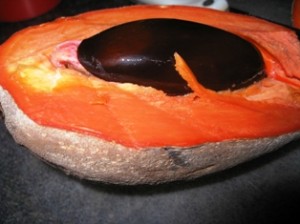Summer’s been over a while, and my food habits had gotten lazy. I needed a jolt: some dish that could pull me back to caring about food enough to spend the time to cook it. Discovering YDFM‘s bloody fabulous unpasteurized Parmesan was a good start, but it mostly just lead to Alfredo comas and suspicious decisions involving grits. Fall, it seems, was wasted on me. 
But then came October and, better yet, Oktoberfest. Having drunk myself…drunk…all month, I ended up finding myself with a couple leftover bottles of Paulaner’s delightful seasonal. For reasons best left to everyone’s imaginations (quiet, you!), I realized they’d probably not get consumed in time, so I decided to try something a bit strange with some veggies, also nearly past due: I braised them. In beer. And put Parmesan on top. It’s like a very, very bougie ratatouille, and was bloody delicious, and easy, and a nice way to slide out of fall. I plan to keep on making until I get sick of it, which may be never. And it’ll be a great accompaniment to my Thanksgiving spread.
Here’s the stuff:
Preheat your oven to 350 while you chop.
Fresh fennel, washed and cut into big bits (quarter the bulbs, etc)
Yellow onion, similarly cut
A couple handfuls diced carrot
A couple handfuls diced red bell pepperAnd prep:
Kosher salt
Black pepper
Enough Paulaner Oktoberfest to cover the rest
Parmesan cheese (unpasteurized, though you could use pasteurized too, as long as it’s not from a green cylinder)
Put everything except the cheese into a baking dish, and bake, uncovered, for about 15 minutes (less if the beer is not cold). After that time, take the dish out of the oven, stir things around, and sprinkle some cheese over top of the veggies. Now crank up the oven up to 400 and put the dish back in for 8-10 minutes, until the veggies are cooked. If you’ve used the right amount of beer, the cheese will get all nice and melty and brown, but if you’ve used too much, it’ll just melt into the liquid, which isn’t as elegant but may also be very tasty.
Eat, preferably accompanied by the rest of that giant bloody beer you opened.
Bonus: sopping up the clearly excessive quantities of braising liquid with hearty Bavarian rye bread. For dessert. Or breakfast. Possibly with all that leftover turkey.
-MAW


 When Hernan Cortez conquered Mexico in 1521, chocolate was introduced to Spain. The Spanish added sugar and cinnamon to the bitter drinking chocolate recipes of the Aztecs and Mayans. By the late 1600s, the British discovered the Spanish drink and began adding milk to the recipe, thus creating what would become the winter obsession of people worldwide for the next few centuries. By the mid 1700s, the industrial revolution afforded the technology to create solid chocolate bars.
When Hernan Cortez conquered Mexico in 1521, chocolate was introduced to Spain. The Spanish added sugar and cinnamon to the bitter drinking chocolate recipes of the Aztecs and Mayans. By the late 1600s, the British discovered the Spanish drink and began adding milk to the recipe, thus creating what would become the winter obsession of people worldwide for the next few centuries. By the mid 1700s, the industrial revolution afforded the technology to create solid chocolate bars.
 By Guest Blogger Trish King
By Guest Blogger Trish King I apologize for another horse race, but I have been to the
I apologize for another horse race, but I have been to the

